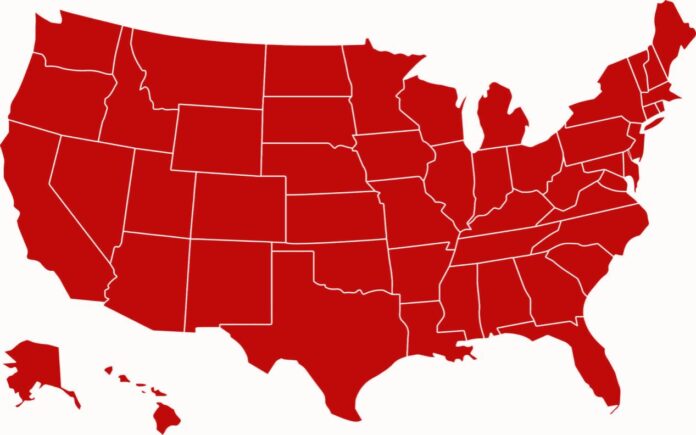A new study from the Williams Institute on Sexual Orientation and Gender Identity Law and Public Policy at the UCLA School of Law finds the LGBTQ+ population in the U.S. is now the largest ever recorded and growing exponentially every few years.
This new research — a 17-page study — estimates the percentage and number of LGBT adults at the national, state and regional levels, and it is revelatory.
According to the new data, 13.9 million adults in the U.S. identify as LGBT, 5.5% of the country’s total population, which is an entire percentage point more than their last report. In 2020, the Williams Institute reported the LGBTQ population represented 4.5% of the population or 11.3 million adults. The new study signifies an increase of 2 million adults and other data in the study suggests the queer and trans populations will continue to grow at a steady pace in the coming years.
Key data points within the study will surprise many, like one point illustrating that more LGBT adults live in the South than in any other region. “More than half (57.0%) of LGBT people in the U.S. live in the Midwest (21.1%) and South (35.9%), including 2.9 million in the Midwest and 5.0 million in the South. About one-quarter (24.5%) of LGBT adults reside in the West, approximately 3.4 million people. Less than one in five (18.5%) LGBT adults live in the Northeast (2.6 million).”
The place with the highest percentage of LGBTQ+ adults is Washington, D.C. at an outsized 14.3% and 81,400 people.
While states with the largest number of LGBTQ+ adults are also the states with the largest populations: California has the most LGBTQ+ people —1,549,600 — but a percentage that is actually lower than the overall percentage at 5.1% and Texas, the second most populous state after California, has 1,071,300 LGBTQ+ people, but like California, only 5.1% and New York has 853,600 LGBTQ+ people but only 5.4%. In terms of percentages, the states with the highest percentages were found in New England and the Pacific Northwest.
The top ten states with the largest percentages of LGBTQ people are, from 1 to 10, including those with tied percentages: Oregon at 7.8% (253,300), Delaware at 7.5% (56,600), Vermont at 7.4% (37,600), New Hampshire at 7.2% (78,400), Washington at 6.9% (398,700), Colorado at 6.8% (294,500), Nevada at 6.6% (150,100), Massachusetts at 6.5% (356,200), Maine at 6.5% (69,900), Rhode Island at 6.5% (54,800), Tennessee 6.3% (328,900), Minnesota at 6.3% (267,600) and Ohio at 6.2% (557,600).
The states with the lowest percentages of LGBTQ+ people are also, according to data from the ACLU, states with among the most anti-LGBTQ+ legislation. Mississippi (93,300) and West Virginia (60,000) led with only 4.1% of the population being LGBTQ+, but Mississippi has 25 proposed anti-LGBTQ+ laws and West Virginia has 12. North Carolina (353,100) has 4.4% and 11 anti-LGBTQ+ laws. Alabama has 4.6% (173,000) and six anti-LGBTQ+ laws.
Iowa has 4.7% (113,600) and 29 anti-LGBTQ bills.
South Carolina (192,800) and North Dakota (28,400) both have only 4.9% of LGBTQ+ people in their populations. But South Carolina has 20 anti-LGBTQ+ bills and North Dakota has 17 anti-LGBTQ+ bills.
Pennsylvania at 5.8% (586,500) and New Jersey at 5.3% (367,300) are in the median range.
The study also cataloged the percent and estimated number of U.S. adults who identify as LGBTQ by age group. Nearly one in six 18-24-year-olds identify as LGBTQ and represent the largest group at 15.2% (4,659,600). One in ten (9.1%, or 4,085,300) of those 25 to 34 years old. Only 4.1% (2,538,400) of those ages 35 to 49 identified as LGBT, 2,7% (1,734,700) of those 50 to 64 and only 1.8% (924,300) of those 65 and older identified as LGBT.
Williams Institute and other studies have suggested that older adults have felt less able to come out to interviewers due to personal safety concerns.
In the study, Williams Institute explains: “Sexual orientation is measured with one question, “Which of the following best represents how you think of yourself?” with response options, “Gay or lesbian; Straight, that is, not gay; Bisexual; Something else; I don’t know the answer” or respondents could refuse to answer. To assess transgender and cisgender status, the question asked is, “Do you consider yourself to be transgender?” with response options, “Yes; No; Don’t Know/not sure” or respondents could refuse to answer. If a respondent expresses confusion, then interviewers provide definitions of transgender and gender nonconforming. If respondents affirmatively answer the question, they are then asked if they consider themselves to be “male-to-female; female-to-male; or gender nonconforming.”
The study also utilized racial and ethnic models and educational differences.
A 2022 Gallup poll found a larger percentage overall of LGBTQ+ people at 7.1% and far more LGBTQ+ people among Gen Z at 21% but with broader less focused questions and less strict research modalities. Read the full December 2023 report here and the 2020 report here.

